Golden Rain Tree: Leaves, Flowers, Bark (With Pictures) – Identification Guide
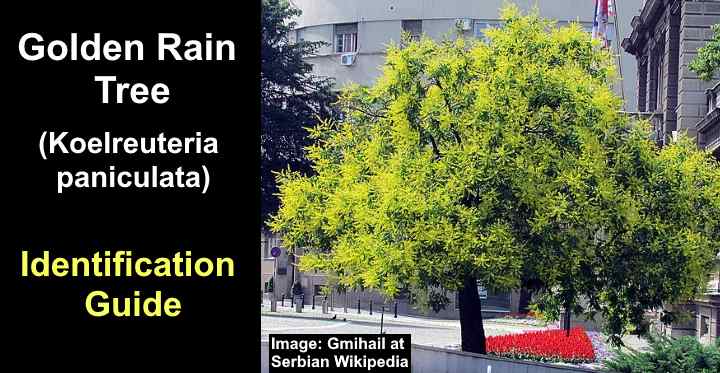
The golden rain tree (Koelreuteria paniculata) is a small to medium-sized deciduous tree. It’s famous for showy yellow star-shaped flowers and lantern-like seed pods. The tree’s name comes from the clusters of bright yellow flowers. These resemble a golden rain shower as they appear to cascade on the tree during summer. Its papery seed pods add visual interest to the tree throughout winter.
Also called the golden shower tree, its ornamental features and low maintenance make it popular for garden landscapes. The beautiful specimen tree grows easily in well-drained soils, tolerating heat, wind, and drought.
This article is an identification guide to the golden rain tree. Descriptions and pictures of the tree’s leaves, flowers, and seeds will help you recognize this beautiful tree in gardens or parks. Additionally, you learn how to grow the tree in your front or backyard.
What is Golden the Rain Tree (Koelreuteria paniculata)?

The golden rain tree is a deciduous ornamental tree in the genus Koelreuteria and soapberry family. Native to East Asia, the tree blooms in summer with clusters of vibrant yellow flowers followed by reddish-brown papery seed capsules. The golden shower tree has pinnate compound feathery leaves, creating dense foliage throughout summer.
The golden rain tree thrives in USDA zones 5 to 9; however, it may struggle in some cooler regions of zone 5. The tree thrives in Florida, Texas, and from Oklahoma to the East Coast of the United States.
Its botanical name honors botanist Joseph Gottlieb Koelreuter and its flowering panicles (paniculata). Other names for the ornamental tree include the China tree, the pride of India, the golden raintree, the golden shower tree, and the varnish tree.
Golden Rain Tree in Florida
The golden rain tree is a stunning ornamental tree with yellow flowers in Florida. Clusters of vivid yellow flowers brighten roadsides, parks, and gardens in the Sunshine State. After the “golden shower,” when the flowering clusters drop, the rounded tree’s canopy displays papery pink or peach-colored seed capsules resembling Chinese lanterns.
Sometimes, the tree’s yellow flowers and pinkish seed pods appear simultaneously, adding to its beauty and visual appeal in the Southeastern United States. However, despite its beauty, the golden rain tree is considered invasive in Florida.
Golden Rain Tree Identification
Let’s look in more detail at the identifying features of the golden rain tree.
Golden Rain Tree Flower
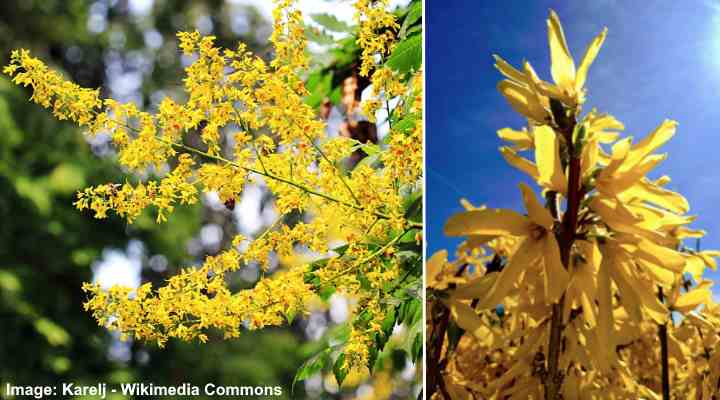
The main identifying feature of golden rain trees is the large, showy clusters of bright yellow flowers. Each flower cluster consists of numerous small, four-petalled flowers in star shapes. The panicles measure between 12” and 15” (30 – 38 cm). The flowers appear in June and July and appear above the foliage.
Resembling a shower of golden blooms, the drooping panicles create a cascading effect as they cover the tree’s canopy. Then, in late summer or early fall, the “golden rain” occurs as the flowers fall from the tree, creating a blanket of yellow beneath the tree. Individual flowers measure less than 0.5” (1.3 cm).
Golden Rain Tree Leaves

Leaves on the golden rain tree are compound leaves consisting of seven to 15 ovate leaflets measuring up to 4” (10 cm) long. Each leaflet has serrated margins and can be deeply lobed. The large compound leaves grow up to 18” (45 cm) in length. They are vivid green above and slightly fuzzy underneath.
Golden rain tree leaves emerge purple to pinkish-bronze. As the season progresses, they turn green, and the dense foliage makes the tree ideal for shade. In the fall, the foliage turns striking shades of yellow or orange, with golden yellow being the most common autumn color.
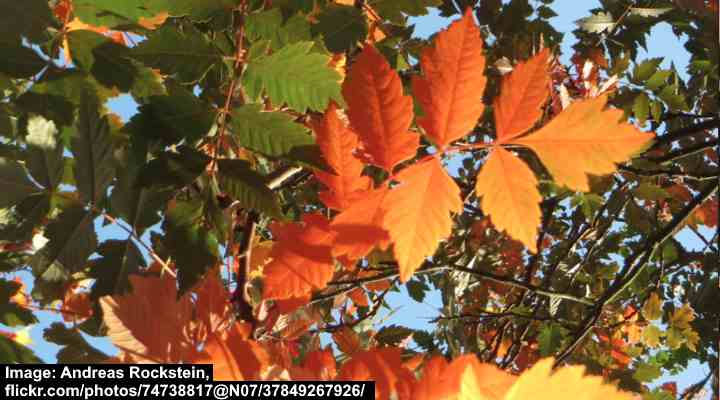
Golden rain tree leaves in autumn
Golden Rain Tree Fruit
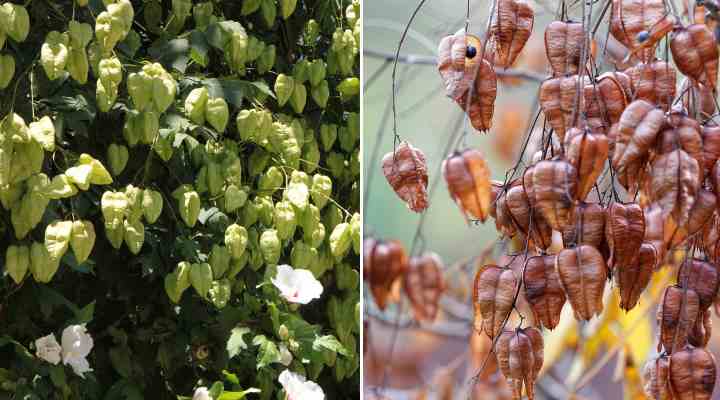
Golden rain tree immature fruit (left) and mature fruit (right)
Fruit on the golden rain tree is small papery copper, brown, or pink capsules resembling a three-sided balloon. They appear in late summer and early fall and create a colorful display, contrasting with green foliage and yellow flowers. The seed pods emerge green before turning shades of pinkish-brown.
Golden rain tree seed capsules measure 1.5” to 2” (4 – 15 cm) long and appear from August through October. The pods have three compartments containing small, black, pea-sized seeds. Due to the number of seed pods, each golden rain tree can produce thousands of seeds in the fall.

Golden rain tree seeds
The golden rain tree has fast growth and self-seeds easily. These features mean that the tree can become invasive in its non-native habitats.
Golden Rain Tree Bark

The bark of the golden rain is light brown or gray and with an irregular, rough texture. The tree’s bark has flat ridges and reddish-brown shallow furrows. The bark also features gray to dark brown lenticels, making it distinctive.
Golden Rain Tree Twig and Bud Identification
The twigs on a golden rain tree are slender and brown, often with raised lenticels. It has small, round, and reddish-brown or pinkish-brown lateral buds that point upward. From these, compound leaves with serrated leaflets emerge in a purple-lavender color.
Golden Rain Tree Height and Appearance
The golden rain tree grows 30 to 40 ft. (9 – 12 m) tall and wide. It has an open branching habit with a vase shape and a rounded or umbrella-shaped crown. The fast-growing has a graceful silhouette in winter when the leaves have fallen.
The tree’s medium size and dense foliage make it an attractive landscape shade tree.
Golden Rain Tree Growth Rate
The sun-loving golden rain tree has a moderate to fast growth rate. Growing in the right conditions, the tree’s annual grow rate is 1 to 2 ft. (0.3 – 0.6 m). In the coolest growing zones (zone 5), the golden rain tree may not reach its full potential.
The golden rain tree’s rapid growth means that its wood is weak. Because of that, the branches are prone to breaking and blowing away in strong winds and storms. Therefore, you should consider the local climate conditions before planting a rain tree in your yard.
Golden Rain Tree Care
The golden rain tree requires minimal care to thrive. You should plant it in a sunny location in well-drained, dry to medium soil. Although it tolerates drought and heat, it is best to water it regularly to keep the ground moist. Prune the golden rain tree in late winter to remove dead wood and keep its shape.
Sun requirements
Golden rain trees thrive in full sun, requiring at least six to eight hours of direct sunlight daily. However, the ornamental trees can grow well in partial shade. Full sun exposure ensures optimal growth, flowering, and overall health. Too much shade can cause reduced flowering, sparse foliage, and fewer ornamental seed pods in the fall.
Watering needs
Golden rain trees prefer regular watering to get established. You should water the roots deeply, ensuring they are saturated. Especially during dry periods, providing a consistent supply of moisture is vital. The soil should be evenly moist but not waterlogged. It’s best to let the top soil dry out between watering.
Golden rain trees are drought-tolerant once established. Therefore, you should adjust watering based on weather conditions and soil moisture levels.
Soil
Golden rain trees thrive in well-drained soil. The beautiful ornamental tree adapts well to various soil types, including clay, loam, and sandy soils. It also performs well in urban environments because it tolerates pollution.
Good drainage is the most crucial care aspect for growing golden rain trees. The trees don’t perform well in soggy soils because they are susceptible to root rot. However, they can withstand periods of drought.
Amending the soil with organic matter enhances soil nutrient levels and drainage.
Fertilizer
Golden rain trees benefit from a good tree fertilizer to help them get established. After planting the tree in the ground, it’s good to fertilize it monthly during the growing season for the first three years. You can use a general tree fertilizer with an NPK rating of 16-8-8.
It’s vital to avoid over-fertilizing golden rain trees. Too much fertilizer can burn the roots. It also causes excessive vegetative growth at the expense of flowering. Regularly monitor the tree’s health and adjust fertilization based on specific needs. It’s wise to test the soil’s nutrient levels before applying fertilizer.
How to Prune a Golden Rain Tree
Regular pruning is vital to ensure the health and vitality of a golden rain tree. The time to prune the tree is in late winter or early spring before new growth occurs. First, inspect the tree for any diseased, damaged, crossing branches. You should remove these branches. This encourages healthy growth and prolific blooming.
However, the low-maintenance, easy-grow golden rain tree doesn’t require routine pruning to encourage blooming or new leaf growth.
How to Propagate Golden Rain Trees
Golden rain trees are easy to propagate from seed or cuttings. Here are some ways to grow a golden rain tree.
Propagating from seed:
- Collect seed pods that are brown and dry.
- Soak seeds in warm water for 24 hours.
- Next, plant the pea-sized seed an inch deep in the soil, 6” (15 cm) apart.
- Keep the soil moist, not allowing it to dry out.
- After germination, thin out weaker seedlings.
- Once large enough to handle, transfer them to a sunny location with well-drained soil.
- Plant the small tree saplings 10 to 15 ft. (3 – 4.5 m) apart.
Propagating from cuttings:
- Take semi-hardwood cuttings from the tree stems in summer.
- Dip the cut end of the stem cuttings in a rooting hormone.
- Plant the cuttings in a small pot in well-drained soil.
- Cover and seal in a plastic bag to increase humidity.
- Place the potted cuttings in a warm, bright location.
- Keep the cuttings moist by misting the soil every other day.
- Wait until roots develop before transferring the rooted cuttings to a sunny place in your backyard.
How to Plant a Golden Rain Tree
The easiest way to grow a golden rain tree is to buy a small potted tree from a reputable nursery. Here is a step-by-step guide on how to plant a golden rain tree in the ground:
- Select a sunny spot where the soil drains well.
- Dig a hole the same depth as the root ball and up to three times wider.
- Using a garden fork, loosen the soil at the base of the hole
- Amend the soil with compost, rotted manure, peat moss or other suitable organic matter to enhance nutrient levels and drainage.
- Place the small tree sapling in the hole, ensuring the root ball is at the same height as in the container.
- Backfill the hole with fertile soil, pressing it down to remove pockets of air.
- Thoroughly water the tree, ensuring the root ball and surrounding soil are saturated.
- Last, spread a layer of organic mulch around the tree’s base to retain moisture.
Watering the tree’s roots regularly during its first year is vital. This helps to develop a good and robust root system and establish the tree.
Golden Rain Tree Pests
Golden rain trees are relatively resistant to common tree pests and destructive insects. Bugs like aphids, scale insects, and leafhoppers can affect rain trees but rarely cause significant damage.
The golden rain tree bug (Jadera haematoloma) is the most common insect affecting trees in the Koelreuteria genus. Related to black and red boxelder bugs, the harmless insect has a black body with striking red-orange markings. It feeds on seeds of golden rain trees and other plants.
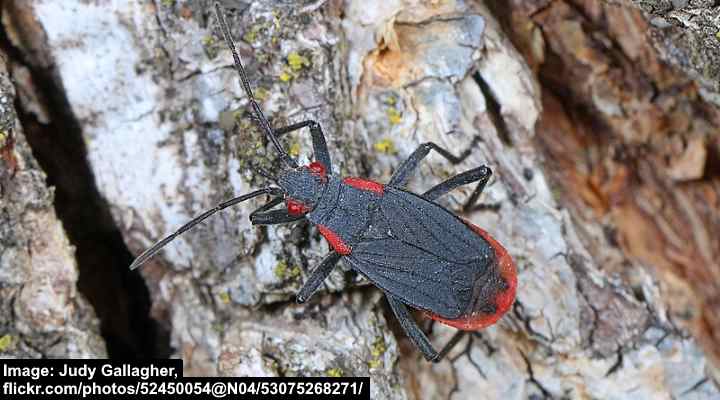
The golden rain tree bug (Jadera haematoloma)
Also called the red-shouldered bug or Jadera bug, it’s harmless to humans. The black bugs don’t bite, sting, or cause structural damage. The only issue the scentless nuisance pests cause is that they stain fabrics red when squashed.
Golden Rain Tree Diseases
The beautiful ornamental golden rain tree is generally resilient to disease problems. The most common tree diseases to affect them are coral spot fungus, root rot, and cankers. However, the soil-borne fungal disease verticillium wilt can cause significant harm to the tree, causing its leaves to wilt. Ultimately, the fungal disease can kill the tree.
FAQs — The Golden Rain Tree
Is the golden rain tree messy?
Golden rain trees can be quite messy due to their habit of shedding leaves, flowers, and seed pods. After the “golden rainfall,” the area under the tree is a beautiful golden yellow carpet. However, the large papery seed pods can create a mess on the ground. Also, the tree’s weak branches easily break off in high winds.
Is the golden shower tree invasive?
Golden rain trees are considered invasive in several regions of North America. The tree self-seeds easily, making it weedy. If left uncontrolled, they quickly outcompete native plants, leading to ecological imbalances. Therefore, checking local regulations before planting a golden rain tree is crucial.
Consider planting non-invasive alternatives instead. Some good rain golden tree alternatives include dogwoods, eastern redbud trees, or serviceberry trees. These species provide similar benefits to golden rain trees, such as attractive flowers and foliage, without the risk of becoming invasive.
Why is my golden rain tree not blooming?
A golden rain tree can fail to bloom for several reasons. The first is that it can take five or more years to produce its characteristic yellow flowers. Other reasons for a lack of flowers can be insufficient sunlight, poor pruning techniques, or a lack of soil nutrients.
Why is my golden rain tree dying?
Fungal infections are the most common reasons for poor growth and the death of a golden rain tree.
According to the University of Florida, golden rain trees are prone to verticillium wilt. Symptoms start as wilting stems and leaves on the lower or outer parts of the tree. In older rain trees, this fungal infection can kill the tree. Adequate fertilization can boost the tree’s strength and enable it to resist the fungus.
Related articles:
